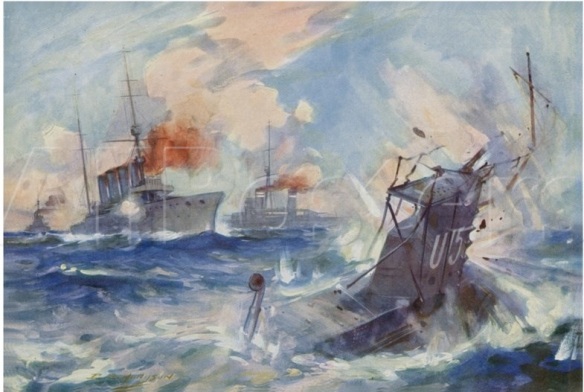A painting depicting the final moments of U-15.
9 AUGUST 1914
On 8 August 1914, the First Light Cruiser Squadron, part of the Royal Navy’s Grand Fleet based at Scapa Flow, had set out on a patrol. Comprising HMS Southampton, HMS Birmingham, HMS Liverpool, HMS Falmouth, and the recently joined HMS Nottingham, the First Light Cruiser Squadron had been ordered to capture or sunk German trawlers, as well as destroy the wireless apparatus on any neutral trawlers encountered.
The patrol was relatively uneventful until about 03.00 hours on the morning of Sunday, 9 August 1914, at which point the cruisers were to the northward of Kinnaird Head on the east coast of Scotland. Lieutenant Stephen King- Hall, who had just come off the first watch, later recalled what happened next:
“I was awakened by the noise of the alarm bells ringing furiously. I pulled on some clothes and ran up on deck, to find it was early dawn, rainy and misty. Every second or so the mistiness ahead was illuminated by a yellow flash, and the crash of a gun followed.
“Suddenly the Birmingham loomed up straight ahead, or a shade on our starboard bow, distant about 2½ cables (500 yards). It was difficult at the moment to say whether the shells falling between us and the Birmingham were being fired by the Birmingham, or at her from a ship on the far side. I restrained our quarter-deck guns’ crew from firing into the Birmingham; she looked rather Teutonic in the early morning light. The mystery of the alarm was settled by the sudden appearance of part of the conning-tower of a German submarine, exactly between ourselves and the Birmingham. How the Birmingham actually turned and rammed her I could not see; but she did, and when the Birmingham turned away, a large oily pool, bubbling furiously, with three black objects resembling air-flasks floating in it, was all that remained of the U-boat.”
The victim of the ramming by HMS Birmingham was the Type U13 submarine U-15. Despite the thick fog, an alert look-out on the cruiser had spotted U-15 stationary on the surface, her engines having apparently failed. Birmingham’s guns opened fire, damaging the submarine’s conning tower and periscope. At the same time, her captain, Captain Arthur Duff, ordered the cruiser’s engines to full speed. At the same time, the U-boat’s commander, Kapitänleutnant Richard Pohle, instructed his crew to dive, but his actions were too late. Moments later HMS Birmingham’s bows slammed into U-15. The U-boat rolled over and sank with the loss of all hands – twenty-five men in total. She was the first U-boat loss to an enemy warship and the first U-boat sunk in the First World War.
